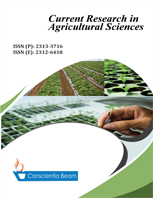Enhancing Broccoli growth by bacillus rhizosphere bacteria
DOI:
https://doi.org/10.18488/cras.v11i2.3945Abstract
This study examines the enhancement of broccoli growth by Bacillus Rhizosphere. Bacteria Broccoli is a nutrient-rich vegetable known for its high content of polyphenols, flavonoids, vitamins, minerals, fiber, and low calorie count, making it a recommended daily food. Tropical regions grow broccoli in mountainous areas. Sustainable agriculture emphasizes minimizing chemical fertilizers, and biofertilizers like Plant Growth Promoting Rhizobacteria (PGPR), such as Bacillus, can reduce their use. Bacillus improves plant growth by fixing nitrogen, solubilizing phosphate and potassium, and producing phytohormones. Understanding Bacillus growth dynamics is vital for optimizing its agricultural application. This study aimed to analyze growth curves of different Bacillus species and investigate their potential role in promoting broccoli growth. This study was carried out in January–April 2024 at the Soil Biology Laboratory, Faculty of Agriculture, Universitas Padjadjaran, and Bumi Agro Technology Company, Lembang. The research was divided into 3 stages: growth curve determination, Bacillus liquid inoculant preparation, and application of treatment to plants. The findings showed that isolates of B. safensis strain MDL5, B. altitudinis strain RPW2, B. subtilis strain YPS4, and Bacillus sp. strain SZ057 reached the highest point in their growth curves after 4 and 5 days of incubation. After that, the curves slowly went down. Inoculating Bacillus into broccoli plants resulted in an increase in plant height by 43.28–58.75% compared to the control.

